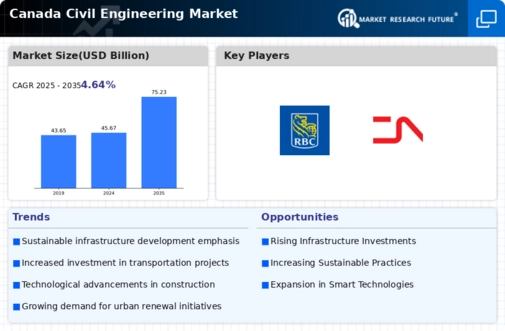Urbanization and Population Growth
The rapid urbanization in Canada is a pivotal driver for the civil engineering market. As cities expand, the demand for infrastructure such as roads, bridges, and public transport systems increases significantly. Statistics indicate that urban areas are projected to house over 80% of the Canadian population by 2030. This trend necessitates substantial investment in civil engineering projects to accommodate the growing populace. Furthermore, the civil engineering market is likely to experience a surge in demand for residential and commercial buildings, as well as utilities to support urban living. The need for sustainable urban planning and development is also becoming increasingly critical, as municipalities strive to create livable spaces that are resilient to climate change. Thus, urbanization and population growth are essential factors driving the civil engineering market in Canada.
Government Infrastructure Investment
Government investment in infrastructure is a crucial driver for the civil engineering market in Canada. The federal and provincial governments have committed to significant funding for infrastructure projects, with budgets exceeding $180 billion allocated over the next decade. This funding is aimed at enhancing transportation networks, upgrading water systems, and improving public facilities. Such investments not only stimulate economic growth but also create job opportunities within the civil engineering sector. The civil engineering market is expected to benefit from these initiatives, as they lead to an increase in project tenders and contracts. Additionally, the focus on modernizing aging infrastructure presents opportunities for innovative engineering solutions. As governments prioritize infrastructure development, the civil engineering market is poised for growth, driven by public sector funding and strategic planning.
Technological Advancements in Engineering
Technological advancements are revolutionizing the civil engineering market in Canada. The integration of cutting-edge technologies such as Building Information Modeling (BIM), drones, and artificial intelligence is enhancing project efficiency and accuracy. These innovations allow for better planning, design, and management of civil engineering projects, reducing costs and timelines. For example, the use of drones for site surveys can decrease the time required for data collection by up to 50%. As these technologies become more accessible, firms in the civil engineering market are likely to adopt them to remain competitive. Furthermore, the potential for improved safety and risk management through technology is driving its adoption. Thus, technological advancements are a significant driver of growth and transformation within the civil engineering market.
Environmental Regulations and Sustainability
The increasing emphasis on environmental regulations is shaping the civil engineering market in Canada. Stricter environmental standards and sustainability goals are compelling engineering firms to adopt eco-friendly practices and materials. The civil engineering market is witnessing a shift towards green building techniques, waste reduction, and energy-efficient designs. For instance, projects must now comply with regulations that mandate the use of sustainable materials and practices, which can lead to higher initial costs but lower long-term operational expenses. This trend is likely to drive innovation within the industry, as firms seek to develop solutions that meet regulatory requirements while also appealing to environmentally conscious clients. Consequently, the civil engineering market is adapting to these challenges, positioning itself as a leader in sustainable development.
Aging Infrastructure and Rehabilitation Needs
The aging infrastructure in Canada presents a pressing challenge and a substantial opportunity for the civil engineering market. Many critical structures, including bridges, roads, and water systems, are reaching the end of their service life and require urgent rehabilitation or replacement. Reports indicate that approximately 30% of Canada's bridges are over 50 years old, necessitating immediate attention. This situation creates a demand for civil engineering services focused on assessment, repair, and modernization of existing infrastructure. The civil engineering market is likely to see increased activity in retrofitting and upgrading projects, driven by both safety concerns and the need for improved functionality. As municipalities and provinces prioritize infrastructure renewal, the civil engineering market stands to benefit from the influx of projects aimed at addressing these rehabilitation needs.













Leave a Comment